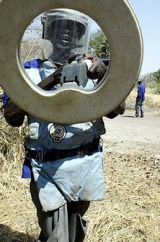Landmines taking heavy toll on South Sudan population
Jan 11, 2006 (KHARTOUM) — Bdreldeen Ahmed was 25 years old the day he and a group of Sudanese soldiers walked into a booby-trapped farm in Kapoeta, a town in the southern Sudanese state of Eastern Equatoria that had been surrounded by rebels from the Sudan People’s Liberation Movement (SPLM).

|
|
A member of the Swiss Foundation for Demining (FSD) team surveys an area near Rumbek, January 2005, to retrieve landmines. |
Now 36 and confined to a wheelchair, Ahmed described the day his life changed forever.
“We were walking through a big farm. We could see the SPLM taking food and fuel for their people. We never saw it coming and didn’t expect anything. Four officers died immediately; six others were injured,” he said.
The detonation of the first mine set off a network of other explosions. Ahmed was hit in the spine by a small piece of metal.
After being hit, Ahmed went into a state of shock. “I felt no pain, so I thought I was OK. I wanted to help the others — some had lost their legs — but I couldn’t move. When the other soldiers came to help me, I fainted.”
Due to the lack of road infrastructure and heavy rains, it was 48 hours before he received medical attention. After examining Ahmed’s wounds, the doctor told him he would never walk again.
Thousands of victims
During Sudan’s 21-year civil war, which began in 1983 and claimed two million lives, both government and rebel forces used landmines. Southern Sudan is still riddled with landmines placed by the army to defend its positions and by the SPLM to restrict the movement of government troops.
In 2003, the United Nations Mine Action Office (UNMAO) was established to coordinate all mine-related programmes in Sudan.
Accurate numbers of people affected by landmines since the beginning of Sudan’s civil war are unavailable. UNMAO reported, however, that since the agency was established, there had been 410 victims in South Kordofan, 352 in Kassala, 233 in Blue Nile and 224 in Upper Nile, the four states with the highest number of recorded landmine incidents.
Nearly 200 landmine-related accidents were reported in Central Equatoria and Western Bahr al Ghazal. Altogether, there had been reports of approximately 2,000 incidents.
Takuto Kubo, UNMAO senior project manager, said that this number did not accurately reflect the extent to which Sudan had been affected. Beyond posing physical danger, landmines had also rendered roads impassable and agricultural land useless.
Landmines are of particular concern for returning populations that had been displaced during the civil war.
“These refugees and IDPs [internally displaced persons] may return to mine/UXO [unexploded ordnance] affected areas. They do not know the current situation after long absence from their own communities,” Kubo explained.
To address this issue, UNMAO had launched educational activities about landmines throughout Sudan, focussing especially on returning IDPs. The organisation had also cleared and verified return routes to ensure their safe passage.
Kubo said that some parties had complained that the de-mining process was too slow.
“This unfortunately is the true nature of the work,” he said, adding that a lack of funding also hindered the clearance teams’ work.
With adequate financial support, Kubo said, UNMAO would be able to clear 80 percent of the high impact areas within three to five years.
Reintegration of the disabled community
Initially, Ahmed was in so much pain from the accident that it did not really register that he would never walk again.
“All I wanted was for the pain to stop,” he said. “After it did, I thought: How do I live in a wheelchair for the rest of my life?”
In 1997, Ahmed helped to establish Arbrar, an NGO that assists victims of landmines.
“The idea started during the war because so many people had been disabled — and not only solders but civilians,” he said. “They needed an organisation that would provide not just money, but motivation, care and friendship.”
As a disabled person, Ahmed said he understood the key concerns of the newly disabled and how to help them.
“The most important thing was social integration, because in Sudan people tend to think a disabled person is a useless person. The disabled person also thinks that they are unable to work and can do nothing but stay home,” he said.
Arbrar provides income-generation projects, counselling and social contact to members of the disabled community. The organisation also encourages them to enrol in school, which offers access to a wider range of opportunities.
Ahmed said that although his experience had been difficult, he has learned to focus on the positive instead of the negative. “We say in Arabic, ‘No despair with life and no life with despair.’ You have to want to live. You have to want to discover your capabilities regardless of your limitations.”
(IRIN)
